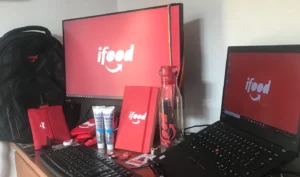iFood has already started 2022 with great news: we are the first company in the Americas to be able to use drones for meal delivery. In January, our partner Speedbird Aero, which develops drones with national 100% technology, received authorization from Anac (National Civil Aviation Agency) to make deliveries of up to 2.5 kg within a radius of 3 km.
O use of drones and robots It is one of the paths we see in the delivery of the future, but it is not the only one. On this journey, iFood is keeping an eye on trends to innovate in logistics and gain efficiency at each stage of delivery, from the restaurant or market to customers' homes.
The drone, therefore, is part of a broader strategy to make deliveries safely, within the promised time and using the best combination of modes available, as the modes are complementary in our operation. Today, iFood is capable of grocery delivery in 5 to 15 minutes, and meal delivery in 20 to 35 minutes.
With the drone guaranteeing the first leg of the delivery, it was possible to reduce the journey between Aracaju and Barra dos Coqueiros, in Sergipe, to 5 minutes — by land, the same journey took 25 to 55 minutes.
With this, we positively impact everyone involved in our ecosystem. For restaurants, we make delivery possible by generating orders from a region that previously did not deliver. For customers, we offer restaurants where it was previously impossible to order due to the long delivery radius. As for the delivery drivers, who will carry out the last leg of the delivery leaving the order at the final destination, we generate more orders, with shorter routes, in a previously uncrowded region that now has more opportunities and gains.
Now, we are planning the next steps to increase the operation in Sergipe and explore new routes across the country, evaluating the 200 addresses already mapped to understand where we can gain efficiency using drones.
The best modal for each delivery
A artificial intelligence It’s another resource we use to be more efficient. Improving the algorithms means increasingly improving the combination of information to decide the best modal to be activated when you place the order. AI will suggest the best combination between modes to guarantee the best delivery time.
Drones and robots are part of this strategy as another method that speeds up deliveries. In the case of ADA robot, it can be efficient both guaranteeing the first leg of delivery and the last. In the first leg, it guarantees efficiency when traveling from the food court and mall restaurants to the iFood Hub shipping center, where delivery people collect the order and take it to customers' homes without wasting time inside the mall.
Drones and ADA will not replace our delivery drivers in the future. Its role is precisely to take charge of the most difficult or time-consuming routes to free up our delivery partners to complete the delivery over shorter distances and, thus, increase their productivity.
An example: ADA's next step will be to deliver within residential condominiums, between the entrance and the customer's home (last leg of delivery). Thus, instead of the delivery person spending up to 20 minutes waiting at the door of a large condominium, he leaves the order with ADA and is free to pick up new orders.
The future of cities
At iFood, the future of logistics follows the future of cities, which points towards using shared, electric and sustainable modes. Sharing a vehicle instead of owning it is a trend, as is choosing the most appropriate mode for each route.
At iFood, for example, we invested in sharing electric bicycles in the program iFood Pedal, which allows the delivery person to move more intelligently around the city. The bicycles are distributed at strategic points, in neighborhoods that concentrate the greatest number of orders. This way, delivery people do not need to leave and return from their homes by bicycle. They can use public transport, for example, until they arrive in a hot region with many orders. In these neighborhoods, in addition to removing an electric bicycle, they can remove safety equipment, bags and use support points.
To top it off, we will also continue investing in encouraging electric motorcycles as solutions to overcome pollution in cities. By 2025, iFood has the goal of delivering 50% of orders using non-polluting modes, such as these. My big dream is to reach 100% in the nearest possible future, with delivery drivers satisfied with the mobility experience around the city, with a better quality of life and greater earnings.
When an innovation in logistics gains scale, our entire ecosystem is positively impacted. Restaurants that can serve a larger audience, delivery people waste less time on delivery and have a better experience, and customers receive the order at the agreed time, with the expected quality and with greater convenience.


